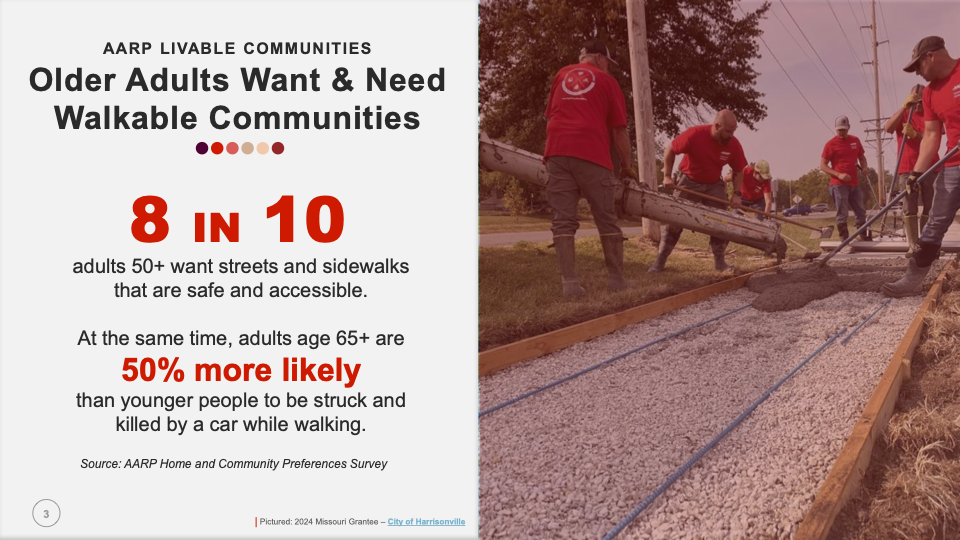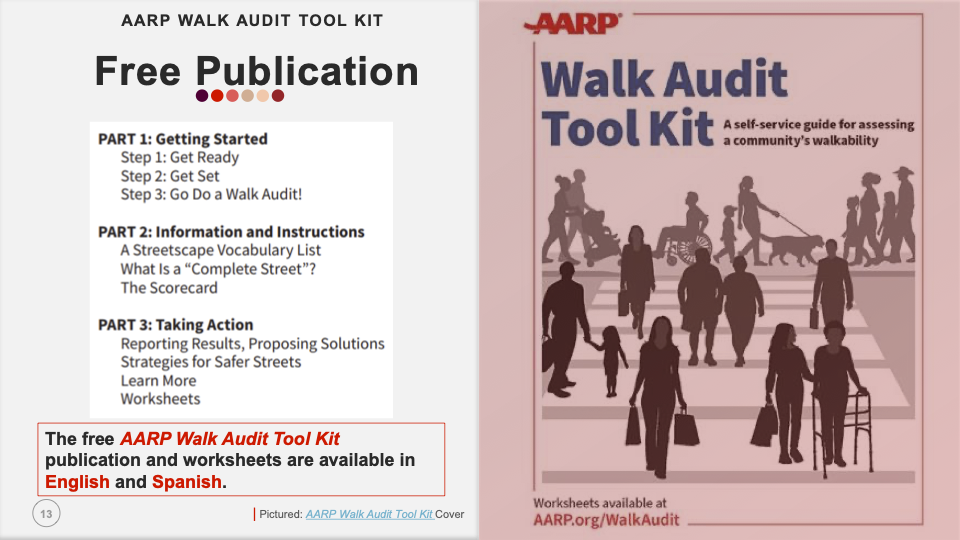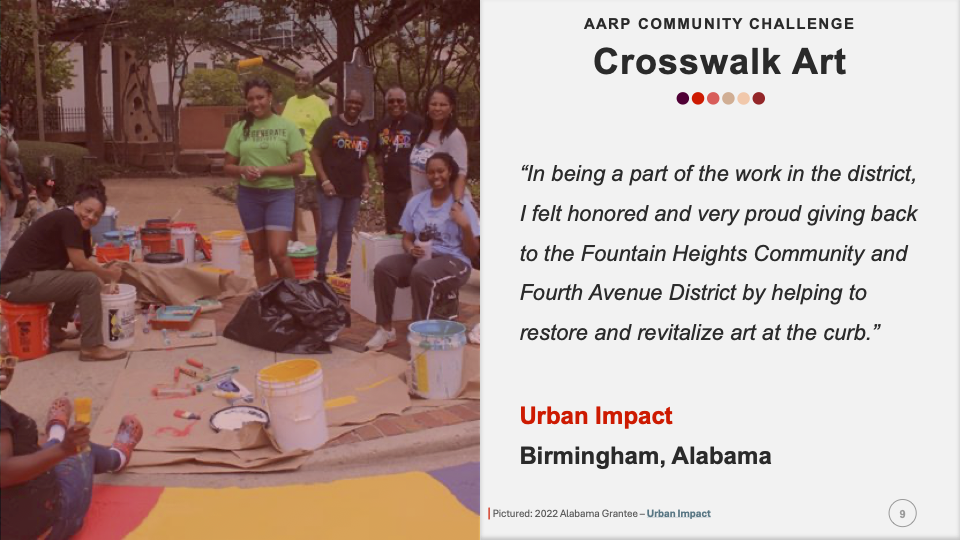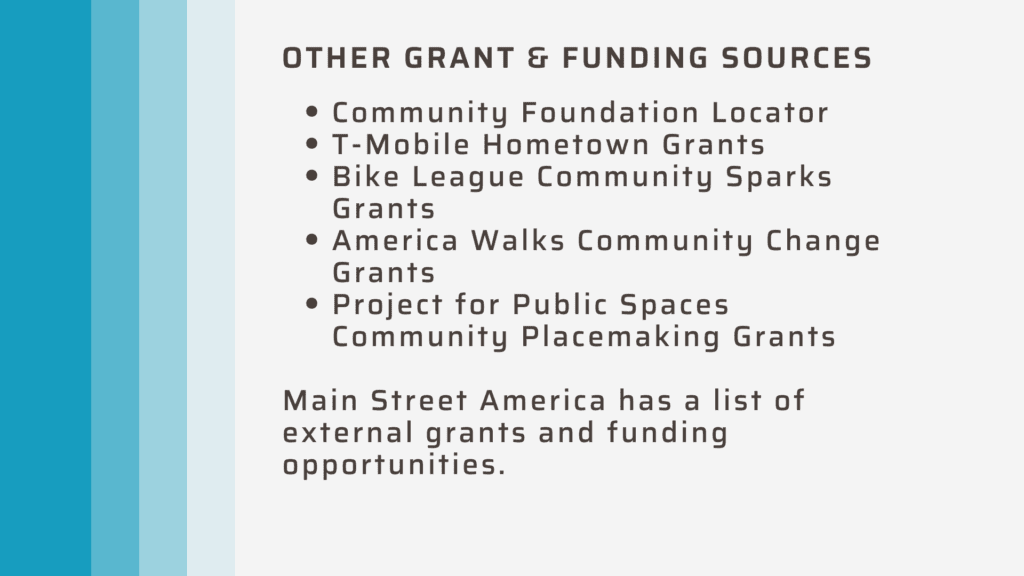Walkability is more popular than ever, but finding funding to promote it is a challenge.
During a recent webinar, America Walks Executive Director Mike McGinn spoke with Martha Roskowski, Principal at Further Strategies, and Rebecca Delphia, a Senior Advisor with AARP’s Livable Communities program, on how non-profit organizations across the country can identify funding sources for their on-the-ground walkability projects.
The webinar was supported by a number of sponsors, including Active People, Healthy Nation, a campaign of the Centers for Disease Control aimed at increasing physical activity and improving health and quality of life.
How to Work with Foundations
Martha Roskowski kicked things off with an overview of the current state of the national foundation landscape. She mentioned that there’s a saying that if you know one foundation, you know one foundation because they are all unique, which makes understanding them as a whole challenging. Many foundations have braced themselves in response to a shifting funding climate and economic uncertainty.
Some foundations also have moved to polling funds, which they then distribute based on specific rubrics because it has become more difficult for individual nonprofits to win grants. Additionally, foundations do still acknowledge that nonprofit organizations need money to operate, many do still have an eye on what is new and shiny — increasing competitiveness. “Stick to the knitting,” Martha advises. “You know the work that needs to be done. Keep doing what you’re doing. It is not the time for dramatic pivots.”
While some national organizations like AARP and America Walks tend to fund local efforts, most national foundations don’t fund local efforts unless they’re part of cohort projects. That’s where it might be more fruitful to work with local and regional foundations. On this front, Martha recommends researching to understand where the money comes from and what they have funded in the past.
The key to working with foundations, says Martha, is building relationships. “If you want advice, ask for money. If you want money, ask for advice.” Build relationships with program officers and foundation leaders long before asking for money. Invite them on tours, for coffee, and to events where you position the work first. If they want to learn more about your work, they’ll likely get around to ask you to submit a grant request.
The Funder Perspective
Rebecca Delphia spoke from the funder perspective on finding grants that can spark meaningful, long-term changes in walkability.
Rebecca explained during her presentation that AARP sees walkability as critical to designing communities that prioritize housing, transportation, public space, and social engagement for people of all ages. Not just a “nice to have,” but a “need to have.” By 2034, there will be more older adults than children in the U.S. for the first time in our history. This demographic shift demands a different approach to allow people to age in place actively and with safety and dignity.

Achieving this vision of walkability requires a comprehensive approach to pedestrian safety. AARP funds such improvements through the Community Challenge grant program and provides training for local leaders and tools, like the Walk Audit toolkit, that they hope lead to action. Additionally, the organization takes part in federal, state, and local advocacy efforts on the ground to create more walkable communities.

The Community Challenge grant program is a quick-action grant program meant to help communities take their first steps towards becoming more livable. The grants fund tangible improvements that energize local efforts, change the conversation, and help demonstrate what’s possible through projects like new crosswalks, benches at bus stations, and pop-ups. Since 2017, the program has funded $24.3 million through 2,100 grants in all 50 states, directly benefiting 12 million people over the age of 50. Half of the grantees have gone on to secure additional funding, overcome policy barriers, and increase visibility and engagement for their work.
But there are many other grant opportunities through AARP, Rebecca explained, including those of all different kinds and sizes. The smaller capacity-building grants come with support from America Walks to conduct walk audit assessments to enhance safety and walkability. Rebecca presented short case studies from Madison, Georgia; Birmingham, Alabama; Minneapolis, Minnesota; Milwaukee, Wisconsin; and Auburn, Maine.

The report highlights seven case studies for small urban transit. It also explores the role transit plays in small city economies and quality of life, as well as challenges and opportunities. Coeur d’Alene, Idaho, and Flagstaff, Arizona, are among the case studies.
Defining the Problem and Project
Wrapping up the presentations, Mike McGinn spoke briefly on other grant and funding sources (found here), as well as provided more context around thinking about funding opportunities.

“The transportation world works on projects,” he said, which is why resources like the Walk Audit toolkit are so great because they can be used to approach a “problem” and identify several sub-projects as part of the “solution.”
Q&A: Telling Your Project’s Story
During the Q&A portion of the webinar, the panelists answered questions from how to communicate with foundations to sourcing supplies for quick-build and other projects.
Think about the messengers for your project, Martha encouraged. Who are the champions? Can they put a different frame on the work and speak to the benefits for the community from their perspective?
Additionally, build community support and engagement around your project. Demonstrate its value and the benefits to the community it serves. The more a community loves a project, the more support it will have politically, including when it comes to defining local budgets. This is especially important when trying to shift the culture around the value of walkability. Quality, safe sidewalks aren’t extra — they’re a necessity!
Rebecca offered several resources to help those interested find money and supplies for local projects. Walk audits, for example, don’t have to be cost prohibitive. Some have been done for under $500. AARP’s Walk Audit toolkit, worksheets, and so many other tools are free (see below). The organization also has micro-grants for supplies, food and snacks, childcare, and anything else you might need for a walk audit.
Mike mentioned that anyone interested in quick builds should reach out to America Walks, which operates a number of programs including Walk2Connect to empower individuals, community groups, and businesses to experience the benefits of person-to-person, shoulder-to-shoulder connection.
But what about invite-only grants? Do your research, says Martha. “Think of six degrees of Kevin Bacon. Find somebody who knows somebody who knows somebody.” Follow any thread you can to understand how a foundation operates. Then work your way up the chain.
Additionally, make sure your work is public. Talk about it on social media and through other storytelling platforms like blogs, local publications, and even community engagement events. Invite local foundation folks and community representatives, such as those who manage your local streets, to take part.
Rebecca echoed that it is vital to tell the story of how a pop-up project, such as a colorful crosswalk, influences a community or even becomes permanent. How does it lead to breaking down policy barriers, leading to more funding, opening up economic opportunities, and affecting traffic speeds, noise levels, and more? “These aren’t siloed issues,” she said, “they have implications for the environment, community health and engagement, and economic development” in communities across America.
For more, watch the whole webinar here!
AARP Resources
- AARP Walk Audit Tool Kit – Learn how to assess and report on the safety and walkability of a street, intersection or neighborhood – and inspire needed change.
- AARP Pop-Up Placemaking Tool Kit – A guide to projects that inspire change – and improve communities for people of all ages.
- AARP Livable Communities Website – Information and inspiration for local leaders. Check out Getting Around: Walking and Livability Library: Walkability for articles, images and tool kits about making communities safely walkable for people of all ages.
- AARP Livable Communities E-Newsletter – A weekly, award-winning newsletter that features livability news, best practices, how-to’s, interviews and more about age-friendly efforts from places near and far.
- AARP Livable Communities Map – Use this interactive map to discover where and how AARP is helping communities become more livable and age-friendly so people of all ages can thrive – and make where they live and want to remain a lifelong home.
- AARP Livability Index – A data-driven platform that measures every community and neighborhood in the US for the key amenities and services that affect the quality of life for people of all ages.
- AARP Community Challenge – AARP’s annual “quick-action” grant program that funds local projects that help make communities more livable for people of all ages. View videos and photos of transportation and walkability projects for inspiration.